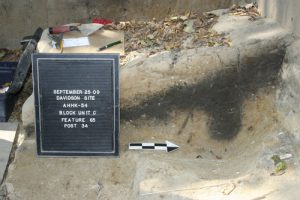
Archaeologists have discovered a 4,500 year old settlement, on the Ausable River, near the shore of Lake Huron in Canada.
The find rewrites the history of the Canadian province of Ontario, proving that people were living a sedentary lifestyle at that time, even though they lacked agriculture and pottery.
Among the discoveries is a 4,500 year old house – the oldest ever found in the province. “It’s semi-subterranean – it’s dug partially down into the ground,” said Professor Chris Ellis of the University of Western Ontario. He led the team that made the find. “It’s as old as the pyramids really.”
The team released a picture of the house, which can be seen at the top of this article. After the house was abandoned it was hit by flood waters. Garbage was piled on top of it – something that helped the archaeologists reconstruct what the structure looked like.
“Because we have the garbage lining the bottom of it we get an idea of the shape of it,” said Professor Ellis. “Also we have the stains left by the posts (that) supported the roof.” Those posts “are fairly large – you’ve got 18-20 centimetre across logs being used to do this.”

What was the house like?
“The house was basically circular,” said Ellis. “It had an entrance on one side – there’s sort of a narrow sloping entrance that faced the river and went down into the actual house pit.”
The house pit was a meter deep and five meters in diameter. This pit would have provided insulation, helping the inhabitants survive the Canadian winter.
“A wooden roof with wooden roof supports would be put over top,” he said. “It also had some posts at the very top that were diagonal – it formed sort of a cone shaped roof.”
In turn “that would be covered with logs – and probably covered with sods and things like this, although we don’t know that for sure.”
There’s more – “you had this circular bench all the way around,” said Ellis, extending half a meter off the ground. “We also found some remnants of what apparently are partitions and things like this that divided the house up into different sections.” Unfortunately “parts of the floor had been eroded away” by flooding, making it hard to determine where all the partitions were. There may have been hearths on the floor as well.
Ellis said that the house would have been used as a single family dwelling and took a considerable amount of time and resources to build. “This is a substantial house, it’s a winter house, people only go to the trouble – even in the winter – of digging big substantial houses like this if they’re not going to move at all in the winter.”
This research was funded by the Social Sciences and Humanities Research Council of Canada (SSHRCC).

The settlement
The settlement is about two hectares in size – but only a tiny portion of it has been excavated so far. The rest of the settlement is known only through magnetic surveys and artefacts found on the surface.
Archaeologists can tell that there would have been a small community there. From the magnetic survey “we know that the site is just covered with buried features of one kind or another,” said Professor Ellis. In one section of the site, a ploughed field, “there are literally millions of artefacts over the surface.”
Artefacts found at the site include spear-points, bifaces, fire cracked rock and even a net sinker. The team has also found abundant organic remains including deer and fish bones, black walnuts and raspberry seeds.
These finds suggest that the site may have been used year round. Fish are caught in the summer and walnuts are harvested in the fall. Semi-subterranean houses are, of course, used to provide insulation in the winter.

Staying put
To the north of the 4,500 year old house the team found a storage area, a meter deep and 1.5 meters across. This is further evidence that, despite living a hunting/gathering lifestyle, people were here to stay.
“You can store a lot of different things like acorns and black walnuts and things like that,” said Professor Ellis.
The site also had extensive areas for disposing of garbage. “We have organized garbage dumps or refuse disposal,” said Ellis. “If you’re only occupying a site for a very short period of time you don’t have to worry too much about garbage accumulation.”
On the other hand – “if you’re going to stay in one place for a fair amount of time, for several months, then you have to start disposing of that refuse systematically,” he said. “That’s what they were doing at this site.”
Just to the east of the house “I’d say within seven or eight meters – there was a big natural ravine or erosional channel – and that erosional channel is filled with refuse from top to bottom – it’s over a meter deep.”
Later houses
The other three structures, found at the site, date to later times – the youngest being about 2,500 years old.
That particular house was found directly above the 4,500 year old house. “Although it’s not a pit house, it was a surface house,” said Ellis. “It was outlined by a wall trench in which posts had been made – it was about four meters across and that one I think dates to about 2,500 years ago.” The fact that it wasn’t dug into the ground suggests that this house was a sort of summer or warm weather residence.
Another house, found at the site, dates back to about 3,000 years, just before pottery was introduced into Ontario. “The posts suggest only part of the house was dug down into the ground with a raised or ground level area around the back of the structure (e.g. the house is bigger than the housepit itself),” wrote Ellis in an email.
A third structure is even stranger – it doesn’t seem to be a house at all. It, “was like a platform dug down into the ground,” said Ellis. “It was full of deep pits that seem to be earth ovens that were used over and over and over again.”
It “could be a cook house or something like this.”
Why settle down?
The big question is what would cause people to become sedentary? There is no evidence of crop cultivation at this site – although people in Michigan may have been planting squash. In fact agriculture would not become widespread, in Ontario, until about 1,000 years ago.
Professor Ellis said that – quite simply – we do not know the answer. Archaeological theorists have developed different ideas to explain, in general, why people settle down. Some believe it’s because populations are too high, and people can no longer move around the land and gather food. Others argue that people get tired of moving around the landscape and will settle down the first chance they get.
“There (are) so many different reasons why people might become sedentary – really it’s poorly understood,” said Ellis.
One thing is for sure, the people who settled at this particular site chose an excellent location. “They were taking a wide range of food resources at this location,” said Ellis.
The river would have provided a transportation hub to get to the lake (to fish) and a nearby marsh would have been an excellent place for trapping. There is also plenty of plant food, including walnuts and seed.
And, Ellis said, that even today, 4,500 years after the first house was built, “we see deer all the time on the site.”



